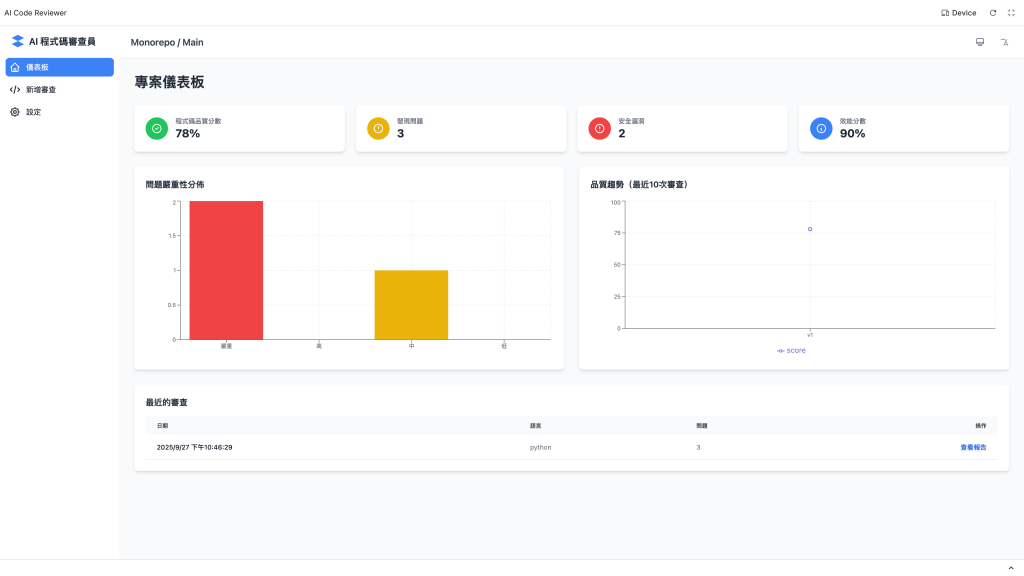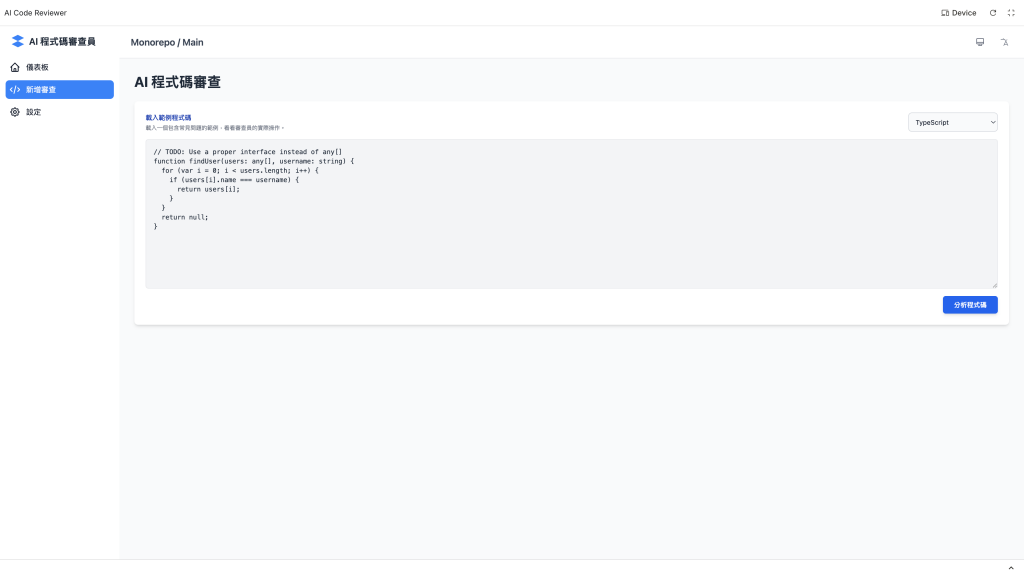軟體開發的快節奏時代,確保程式碼的品質、安全與效率變得至關重要。然而,傳統的手動程式碼審核流程不僅耗時,也容易因人為疏忽而遺漏潛在的漏洞。
此平台主要鎖定軟體開發中的三大痛點:
我們利用強大的 AI 技術,將這些繁瑣的任務自動化,讓開發者能更專注於創造性工作,同時確保程式碼從第一行開始就符合高品質標準。
Please build an AI-Powered Code Reviewer, with the following core features:
### Core Features & Specifications
1. **Code Quality Static Analysis**
* **Error & Issue Detection:** The system must identify and flag potential bugs, logic errors, and common coding issues such as **null pointer references**, **resource leaks**, and unused variables.
* **Performance Analysis:** It should analyze code to find potential performance bottlenecks, including inefficient data structure use, unnecessary loops, or redundant operations.
* **Code Style Enforcement:** The tool must check for adherence to predefined or customizable code style guides (e.g., PEP 8 for Python), ensuring consistency in **indentation**, **naming conventions**, and comments.
2. **Security Vulnerability Detection**
* **Injection Flaws:** The AI model should be trained to detect injection vulnerabilities like **SQL Injection** and Command Injection.
* **Web-Based Flaws:** It must identify common web application security weaknesses such as Cross-Site Scripting (XSS) and Cross-Site Request Forgery (CSRF).
* **Security Misconfigurations:** The system should scan for hardcoded secrets like **API keys** or passwords and improper access controls.
3. **AI-Powered Recommendation Engine**
* **Optimization & Refactoring:** The AI must provide concrete code optimization suggestions and refactoring examples to improve code quality and efficiency.
* **Vulnerability Remediation:** For detected security flaws, it should offer **best-practice code fixes** and detailed explanations of the solution.
* **Readability & Documentation:** It should suggest improvements to code readability, including adding or refining comments and documentation.
4. **Development Workflow Integration**
* **VCS Integration:** The system must integrate seamlessly with major version control systems such as **Git**, **GitHub**, **GitLab**, and **Bitbucket**.
* **PR/MR Automation:** It should automatically trigger code reviews on every Pull Request or Merge Request and post results as comments or status checks.
* **CI/CD Pipeline Integration:** It must function as a step within CI/CD pipelines and can be configured to **block deployments** if critical issues are found.
5. **Supported Languages**
* **Initial Support:** Python, Java, JavaScript, and TypeScript.
* **Planned Expansion:** C++, C#, Go, and other popular languages.
---
### User Interface (UI) / User Experience (UX) Flow
* **Project Dashboard:** A clear dashboard provides a high-level overview of project code quality, including a **score**, **issue distribution charts** (by severity and category), and a **trend graph** showing quality changes over time.
* **Review Report Detail:** Users can access detailed reports that highlight issues directly within the code. The report should display the **line number**, **severity level**, problem description, and the AI's suggested fix.
* **Configuration Manager:** An intuitive interface allows administrators to **customize coding style rules**, adjust severity thresholds, and exclude specific files or folders from analysis.
* **Real-time Notifications:** The system should send notifications via **email** or instant messaging apps like **Slack** and **Teams** upon review completion or when a critical vulnerability is discovered.
* **New Theme Switcher:** A theme icon in the top-right corner allows users to select **Light**, **Dark**, or **System** mode. The app will remember the choice and automatically sync with the device's appearance settings.
---
### Technical Requirements
1. **LLM Model Integration**
* All AI agents must be able to connect to the latest Large Language Models (LLMs).
* Users only need to input their personal **API key** to enable and utilize these features.
2. **Supported Models**
* **Gemini:** gemini-2.5-flash, gemini-2.5-pro
* **ChatGPT:** GPT-5, GPT-4o, GPT-4o mini
* **Grok:** Grok 4, Grok 3
* **Claude:** Claude 4 Sonnect, Claude 3.7 Sonnect
3. **AI Model Architecture**
* The system will use **deep learning** architectures (e.g., Transformer) to understand code semantics.
* The models must support **continuous learning**, allowing them to improve over time based on user feedback.
4. **System Architecture**
* A **microservices** architecture will be used to ensure scalability and high availability.
* The platform will be **cloud-native** and use **RESTful APIs** for seamless external integration.
5. **Language Setting**
* The user interface and all output, including AI-generated suggestions, can be switched between **Traditional Chinese (ZH-TW)** and **English (EN)**.
核心指標卡片: 頁面頂端有四個醒目的卡片,分別顯示關鍵指標:
問題嚴重性分佈圖: 一個長條圖,直觀地呈現不同嚴重性等級的問題分佈。此圖顯示「高」嚴重性的問題最多,其次是「中」,而「低」級問題似乎沒有。這有助於開發者優先處理最 critical 的問題。
品質趨勢圖: 另一張圖表顯示過去幾次審查的品質分數變化,幫助團隊追蹤程式碼品質是正在改善還是惡化。此處以單點顯示,可能表示目前只進行過一次審查。
最近的審查記錄: 頁面下方是一個表格,列出了最近的審查歷史。表格包含日期、語言、審查結果以及一個 「查看報告」 的按鈕,讓使用者可以點擊進入詳細的審查報告頁面。

這款產品原型清晰地展示了一個從 提交程式碼 到 查看綜合分析報告 的完整流程,其儀表板設計簡潔明瞭,能有效協助開發團隊管理和提升程式碼品質。
